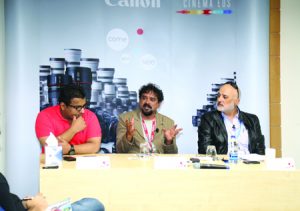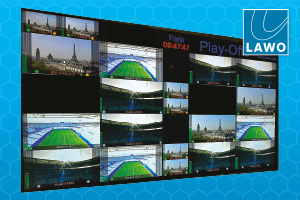Canon Middle East brought together camera experts from different genres including mainstream cinema, production, news and OTT to discuss some of the key elements that helped them nurture their art and factors to keep in mind while choosing a camera. We bring you highlights from the discussion Canon Middle East hosted a roundtable at CABSAT […]

Canon Middle East brought together camera experts from different genres including mainstream cinema, production, news and OTT to discuss some of the key elements that helped them nurture their art and factors to keep in mind while choosing a camera. We bring you highlights from the discussion
Canon Middle East hosted a roundtable at CABSAT titled ‘A Rendezvous with Cinematographers’, which featured celebrated Indian cinematographer Santhosh Sivan; Antoine Atyeh, cameraman supervisor at Al Arabiya News; Sherif Mokbel, DoP at Circus Studios; Khaled Gamal, shortlisted candidate for Canons EOS short film competition; and Mohammed Albsimi, Editor at Electrony.net. The discussion was moderated by BroadcastPro ME Editor Vijaya Cherian.
The objective of the discussion was to help students and budding filmmakers to better understand digital cinematography by bringing together a group of panelists who were specialised in different genres. The attendees included film students and young filmmakers, who heard first-hand from the experts about making the right choices of cameras and lenses when shooting either for film, news, short films or online.
Sivan spoke about his journey in filmmaking and how his love of art triggered his interest in films. He also emphasised how travel had helped him perfect his craft, adding that image capture largely depends on what you see in your frame and how you frame your composition rather than the medium or the tools used to capture it. He encapsulated his experience as an artist and how it set him on a lifelong visual journey.
When I used to paint, I remember how I used to observe everything in great detail, said Sivan.
When you paint, you conjure up a mental image of an object or scene that you see. In photography and cinematography also, your perspective is everything. You observe and then use your camera to translate that on to the screen.
He went on to add that in cinematography, or any art for that matter, nothing is linear everything is organic.
An image should have a blend of light and dark; it should have a mysterious element to it in order to make it more intriguing. You enrich your image capture with elements from your cultural journey, trust your instincts and adapt to the changing times, Sivan told the attendees, adding that for a cinematographer, it is the imagination that should drive the composition forward while the camera will serve to complement that vision.
By comparison, for news, timing is everything. The ability to capture the right moment and shoot only what is relevant so that the cameraman spends minimal time editing with the objective of taking the footage to air as quickly as possible is key in news capture, pointed out Atyeh of Al Arabiya News, explaining that today, a news cameraman must also be able to double up as an editor.
You dont want to shoot too much, capture only what matters. You learn from experience that you mustnt keep shooting hours of footage. The idea is to make an impact on your audience, and little goes a long way some times, he said.
Gamal, who has several short films to his name, commented that time is a challenge for every filmmaker and different situations make different demands of the filmmaker.
Some shots will require more time while others wont. Then again, you wont always have the luxury of time to shoot a scene, he cautioned.
Well-known Saudi blogger Mohammed Albsimi chipped in at this point that the online medium demands a more personal relationship with the viewer.
You shoot, edit and at times, you are also in front of the camera; you do it all. In the digital world also, timing is key that sense of urgency to ensure that you get it online before anyone else. The footage needs to be published immediately; otherwise, it loses its relevance, he explained.
Sivan highlighted that the most beautiful things happen in a fleeting moment and capturing it is challenging.
To be able to capture or anticipate that moment and shoot it is a hugely differentiating factor.
The panel also discussed how art merges with technology and how the cameraman can use technology to his advantage. Mokbel took this moment to recommend the film Senna, which captures events very artistically and blends art and news beautifully.
The discussion moved on to camera specs and what a cameraman would potentially look for, when shooting for a specific genre.
Although Sivan pointed out that this would be dictated by the subject matter and personal choice, he settled on lenses, aspect ratio and anamorphic as the most important. He added that resolution is also important given how more people are shooting in 4K.
The cinematographer, however, cautioned that crisp and clear images are not necessarily flattering to actors faces. High resolutions work better for cars, where such detailing would be appreciated, he stated.
He also commented that aspect ratio is often a personal choice or dictated by cultural mandates.
We shoot most of the Indian movies in anamorphic with narrow aspect ratio, because our theatres are designed for that and it helps get the audience out of the TV mode. For a UK film, on the other hand, I would shoot on a wider aspect ratio, and use a wide variety of lenses.
A dynamic lens range helps design a film as well. Every shot does not have to outdo the other; each shot is designed to work towards a crescendo for a particular scene, he elaborated.
Atyeh commented that cost would impact his choice of camera.
Gamal commented that every film would ideally demand a different mix.
I change my camera for every film, because each films needs are different. But if I had to choose, I would opt for the sensor as it is the most critical according to me.
Mokbel cited ergonomics as having played a crucial role for his style of shooting. He also took the opportunity to do a quick presentation of some scenes he had created. While the final output looked as sophisticated as big budget advertisements, his behind-the-scenes methods of shooting revealed clever planning.
Based on each shot, I can decide which camera I need. If we need to shoot in a moving car, a GoPro may work well, while night-time shooting may be great with a Canon C500. I also use larger cameras, but I cant grab them and use all the paraphernalia that goes with them. Camera movement is very important for me. With this, I can create an impact, such as floating scenes to show something is suspended in the air.
Albsimi, who primarily shoots indoors in a much smaller setup for his blogs, commented that the sensor and lenses were crucial for him as it enables him to shoot in low-light conditions. He also added that for him, battery life was a very important factor.
The discussion touched upon the similarities and differences between various genres. The panellists agreed that a film should be able to connect with its viewers. The cinematographer should be able to speak to his audience through his film.
Frame rate and zoom, the panellists agreed, are fads that come and go. All agreed that the focus should be on making films that have an emotional impact while the technology serves to support that art.
Atyeh recommended keeping it simple and classic.
The roundtable concluded with a discussion on the million dollar question of whether there was potential revenue in short films and online content. Sivans own contribution to Indian and world cinema has, no doubt, been financially rewarding.
The question was directed primarily at the rest of the team. While the panellists agreed that money served an important role, they all declared they wou ld make the films they wanted to make. Albsimi pointed out that his OTT contribution was indeed raking in the dollars. He commented that creating online content for corporates in Saudi Arabia was his bread and butter. Mokbel stated that it is his artistic work that brings clients to his doorstep.
Incidentally, people watch my fun films and come to me and say, they want me to make a film for them. So it has his rewards, he stated.
Sivan added that he was not above such pleasures. Passion and profession go hand in hand, he said.
Its about striking a balance and making films that pay so you can then make experimental films that make you happy, which may or may not pay. Keep your passion in filmmaking alive, develop a style of your own, and make sure every film that you make retains a part of you. Keep it original, he advised.
Atyeh dissusaded the attendees from using smart phones for image capture stating that it a device for communicating.
If you want to make a film, get yourself a camera, he said.
Mokbel concluded that its crucial to enjoy what one does, adding that he left the world of advertising to follow his dream to make films.
Follow your passion, and have a good time while you make films.














































































